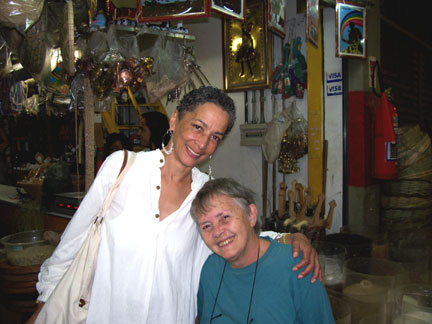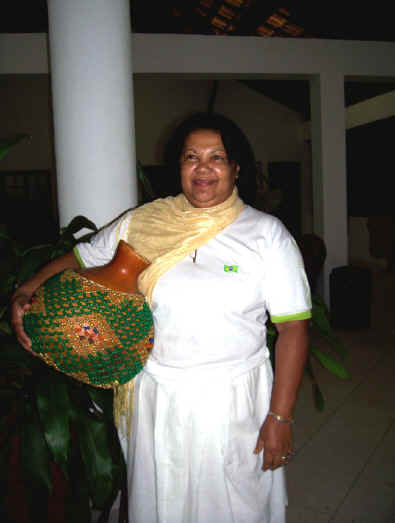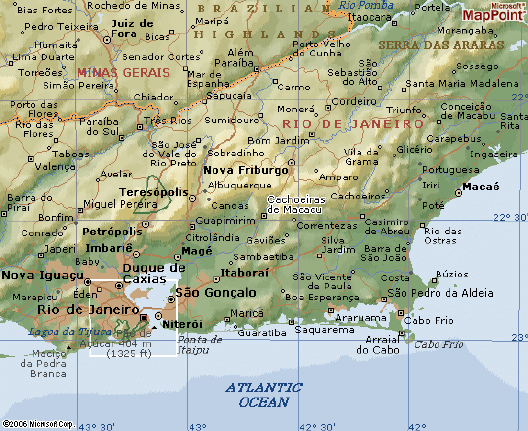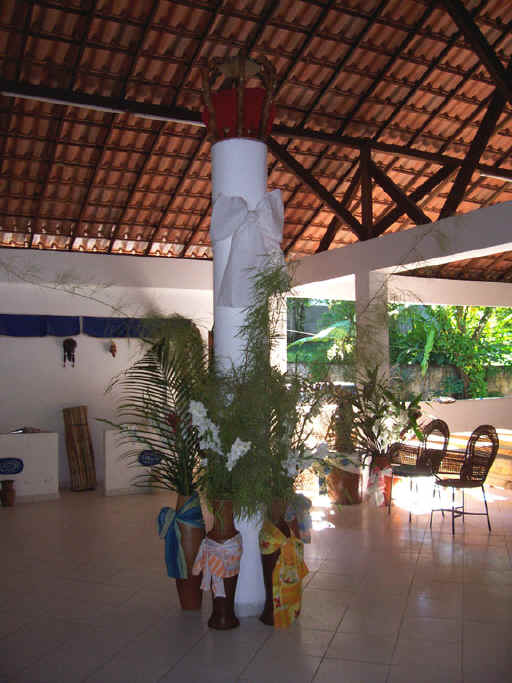
Candomblé trip to Brazil

Denise and Mae Maria in Brazil
For many years I have had a great interest in
Candomblé
Brazil has the largest African descended population in the world - the only country with a larger black population is Nigeria, but Nigeria has 3 major ethnic groups, only one of which - the Yoruba, are followers of Orisha.
Contrary to popular U.S. mythology constructed by Afro-Brazilian tourism marketers, the largest group of Candomblé followers in Brazil are not in Salvador, Bahia but are found in Rio de Janeiro, and Sao Paulo, where there are over 44,000 registered terreiros (Orisha Temple compounds). In the Rio Grande do Sul, the southern-most state in Brazil - 30% of the population in the year 2000 census declared their religion as African.
On May 25, 2006 I finally achieved my dream of traveling to Brazil and to experience Candomblé ceremonies first-hand.
Thanks to Babalorisha & Babalosain Jose Flavio Pessoa de Barros, I was invited to his terreiro, to witness a complete initiation ceremony.
Baba Jose Flavio is from the Ase Casabranca, the oldest Ketu terreiro in Brazil. He is a botanist, anthropologist, ethno-psychiatrist, and has published many scholarly books on Ewe Orisa (plants used in Orisha worship), and other Orisha-related works. His terreiro, Ile Axé Omim is in the mountains near Rio, on the site of a former Quilombo (escaped slave settlement)
The invitation was passed onto me by Mae Maria d'Oxala, a Brazilian Iyalorisha, and anthropologist who I have known for many years. She would be my guide and translator during my stay, since she too was traveling to the terreiro to be a part of the initiation.
According to Mae Maria this was the first time any outsider (of any tradition) was invited to be a part of the entire initiation process in a Brazilian traditional terreiro.
I was extremely honored to receive this invitation, and was able to spend 18 extraordinary days in Brazil - most of them living, working and participating in the terreiro.
As a result of this visit, Baba Jose Flavio has asked that Maria and I develop more of these exchanges between our traditions:
Oloshas, aborishas, artists, musicians and scholars of the African diaspora who are interested in doing this - please contact me:
Please read the Candomble Scam alert
The following pictures and text may not be copied, published or cited without my written permission.
Table of Contents:
Mae Maria and I arrived in Rio on May 26th and were picked up from the airport by Marcos - a Candomblé Shango Ogan.
We then went to the home of Jose Flavio and Lucinha (his wife), located in Rio.
I presented Lucinha with a agbe shekere who my husband Nadhiyr had named "Big Mama", when he made her. She was beaded in mostly yellow with some green (Brazil's national colors) and those colors were also appropriate as a gift for a daughter of Ochun. Shekere's are not used in Candomblé ceremonies, but Iya Lucinha was very pleased with the gift, since she heads a choral music group called Iyun Ase Orin, who perform Yoruba music. The majority of the groups members are also godchildren of Jose Flavio. I had also brought numerous cd's for Jose Flavio - both of jazz and Lukumi ritual music.

Iya Ile Lucinha with "Big Mama"
After several
leisurely cups of coffee with Jose Flavio and a tour of their home, which
included him pointing out numerous plants used in the religion, we piled into
his car, along with one of the family dogs "Feijã

"Cachoeira" means waterfall, and the little town has over 85 of them. At a much higher altitude than Rio, the town is a popular vacation spot for Brazilians seeking to leave the heat of the beach cities in the summer for the cooler mountain temperatures, especially at night. I was surprised by how quickly it gets dark - by 4:30 it was night (June to August are winter in Brazil) and it was very nippy in the mountains. I was glad I had brought some white sweat shirts and pants with me.
The Terreiro
We arrived at the terreiro in the dark - and went straight to the showers for women, where we bathed and then took an herbal bath of "Omiero" afterwards, and then changed into white clothing - skirts for women and pants for men.
Omiero is a ritually prepared solution of water and cleansing shredded herbs with spiritual properties. All guests and ile members must cleanse themselves from the negativities of the outside world before joining into the activities of the terreiro. At any time a person leaves the terreiro, to go shopping or conduct outside business, upon return, an omiero bath is required. This is to insure the sanctity of the sacred space.
door to the women's dorm and showers bucket in shower stall with omiero
dorm room for female members of ile who are spending the night
All persons who are part of the Ile - wear white while going about their daily tasks.
These white
clothes are called "roupa de ração"
(working clothes made of the cheap muslin fabric that was used by the
slaves). Women wear a drawstring saia (skirt) with shokoto
(pants) underneath, and men wear just the shokoto, and a tee shirt.
Ile members dressed in working clothes
The terreiro is built around an open air public main house called a "barracão" (barracks) which has a pointed raised roof and which is the place where the "ashe" of the ile is buried in the floor - in this terreiro it is under a large central pillar called an "inshe". The ashe is made of consecrated materials. All terreiros must have a consecration ceremony - with a central point including the roof, corners and entry gate.

Inshe with Shango crown - a tradition of Casabranca
view of barracão at night
daytime view with close-up of consecrated chairs and objects "dressed" with bows
(laços) in preparation for a shire (bembe - feast)
The barracão is used as an all purpose central room, both for festivals and feasts or drummings, as well as being the place where ile members relax, do ironing, beadwork, eat when not seated in the kitchen at the breakfast table.
The chairs in the photo above are consecrated seats for the Pai de Santo- Babalorisha (the large rattan chair) and for the Ogans (men of the house - see section on functions) and honored guests.
Candomble Terreiro Barracão continued
©